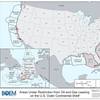IACS Withdraws UR H1: Control of Ammonia Releases
In light of the evolving regulatory landscape for ammonia as a maritime fuel, and the recent finalization of the IMO’s draft interim guidelines on ammonia, the International Association of Classification Societies (IACS) has withdrawn Unified Requirement UR H1, “Control of Ammonia Releases in Ammonia Fuelled Vessels.”
The news comes ahead of its scheduled implementation date of January 1, 2025. IACS says the decision stems from the differences between its safety parameters and those outlined in the IMO Interim Guidelines. The IMO Sub-Committee on Carriage of Cargoes and Containers, at its 10th session, finalized the draft interim guidelines for the safety of ships using ammonia as fuel, with a view to approval by MSC 109.
These guidelines include several differences from IACS’s original UR H1 requirements. The IMO Interim Guidelines establish a 220ppm threshold for acute exposure, without defining a hazardous concentration, and require preventing direct ammonia release during normal and controllable abnormal scenarios, which may exclude releases from leakages. Toxic areas have been defined, requiring gas dispersion analysis to demonstrate concentrations do not exceed 220ppm in key locations.
An ammonia release mitigation system is required to maintain outlet concentrations below 110ppm, with alarms for exceedances. Additionally, alarms must activate at 110ppm with system shutdown at 220ppm, while a visual indication is required at 25ppm near entrances to affected enclosed spaces.
To ensure consistency and reduce the potential for conflicting interpretations, IACS has decided to withdraw UR H1 with a view to publishing a revised version that aligns with the IMO guidelines. The revised UR is expected to be published in 2025.
















